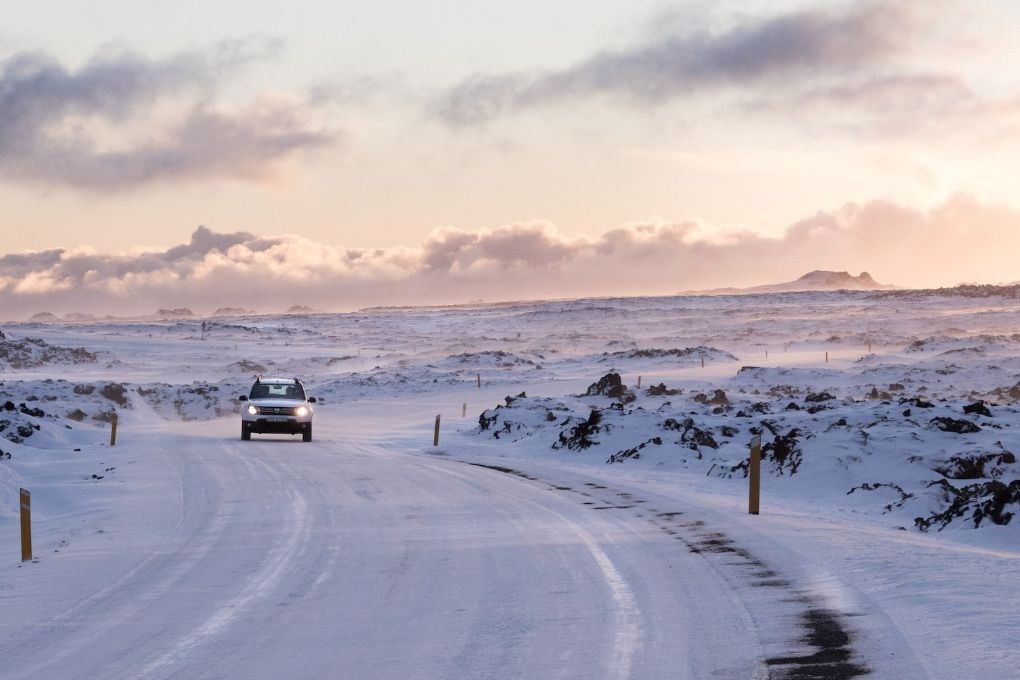
Table of Contents
Gearing up for an Iceland road trip? If you’re planning to visit Iceland in the winter, you’ll need to take some extra precautions. While a winter Iceland road trip can be a magical experience, it’s also one that requires caution. If you’re not properly prepared, you could run into trouble and potentially dangerous situations.
Additionally, to help you best plan your Iceland winter road trip, you’ll need to know a few things. For example, did you know that some parts of Iceland are completely inaccessible and closed off to vehicle traffic in the winter? Likewise, did you know that road closures are, in general, common in some parts of Iceland in the winter months? If you’re not prepared for these facts, you may arrive for your road trip only to be disappointed.
To help you best prepare for driving in Iceland in the winter, we’re telling you…
- What road conditions in Iceland are like in winter
- What kind of car you need to drive in Iceland in the winter
- What kind of rental car insurance you need for driving in Iceland in winter
- Where to drive in Iceland in the winter
- Safety precautions to take before driving in Iceland in winter
And more! These are the seven top things you need to know about driving in Iceland in winter, as well as practical tips for planning your road trip.
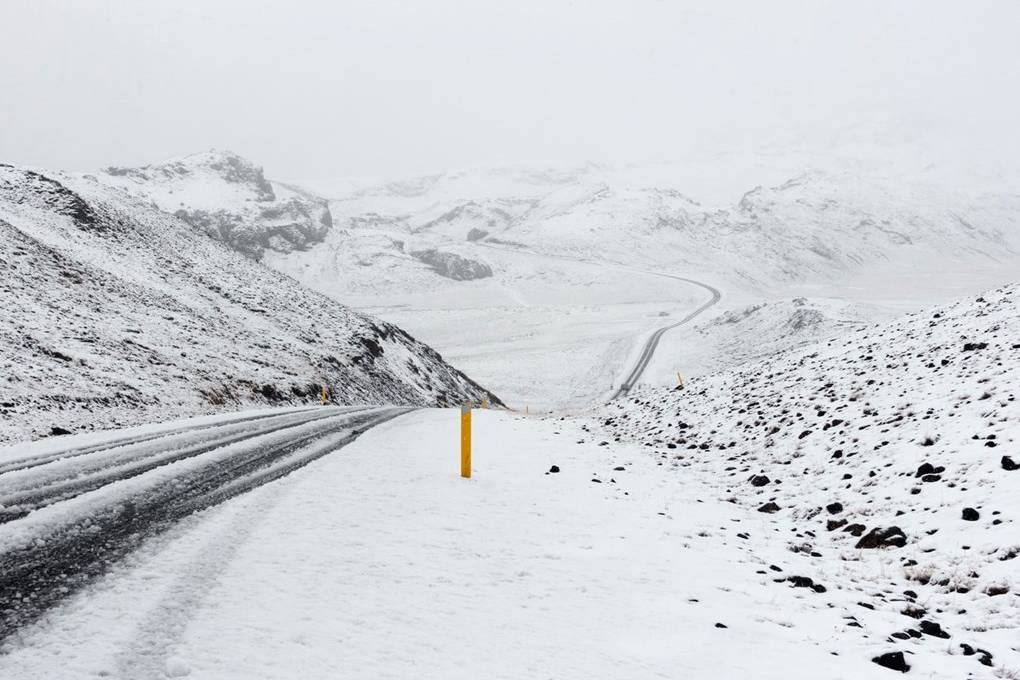
7 Things to Know Before Renting a Car in Iceland in Winter
1. You’ll likely be able to get a great price on renting a car in Iceland in winter
Iceland experiences three travel seasons. There’s the high season in the summer, when demand is highest, more tourists come to the island, and so prices are overall higher for everything you might need, including hotels, rental cars, etc. There’s the shoulder season, which takes place in the spring and fall, when prices are slightly lower, and crowds are slightly lessened. Then, there’s the low season, aka winter.
If you plan on travelling to Iceland in the winter months, you’ll find that prices for rental cars and more are the lowest that they’ll be in the entire year. For this reason, a winter trip to Iceland is a great choice for budget travellers, or just those who don’t want to spend a lot of money on certain parts of their trips, like car rentals, so that they can save their cash for spending elsewhere, like at some of Iceland’s best luxury hot spring spas.
2. There are fewer crowds in Iceland in winter
As mentioned, there are fewer crowds in winter in Iceland, and this is why prices are down, due to the lessened demand. However, you won’t just benefit from the fact that so many travellers avoid Iceland’s harshest weather, which in turn lowers travel rates. You’ll also benefit from the simple fact that fewer crowds mean less-crowded sites and activities.
When visiting Iceland in the summer months, you’ll find that many of the waterfalls, volcanic sites, and popular beaches are teeming with people, especially in areas that are easy to access, close to Reykjavik or Keflavik.
In the winter, though, visitors are much fewer, as not just any traveller is up for exploring the dramatic Icelandic landscapes in the snow, winds and sub-zero temperatures. If you can withstand the weather, you’ll be treated to gorgeous winter landscapes that, in some cases, you have all to yourself.
3. Winter driving can be challenging in Iceland
While winter conditions in Iceland make for fewer crowds and lower travel rates, they also make for more challenging road conditions. The weather doesn’t just impact your time sightseeing. It also impacts the roadways.
Snow, ice and even the strong winds can prove a challenge as you drive along your Iceland road trip. Some of Iceland’s winter winds can even reach or exceed hurricane-level speeds!
Because of this, you need to be properly prepared for driving in Iceland in the winter, and you need to be sure that you, or whoever in your group will be doing the driving, feel up to the challenge. Ideally, you’ll designate a driver for your group, whether yourself or another, who is already experienced in driving in snowy conditions, as well as in a foreign country, where the roadway rules may be different from those in your home country. They’ll need to be mindful of the weather and make smart decisions, sometimes quickly, to keep everyone safe.
One quick tip for your driver? During winter in Iceland, most accidents occur due to black ice, right when the temperature falls just below freezing. “Black ice” refers to ice on the roadway that’s not immediately visible to the driver. Since the driver doesn’t see the ice on the roadway, they continue driving as normal, and they then lose control of the vehicle. If you’re driving in Iceland in winter, be sure to look out for ice and take extra caution while driving, even if the roads look clear.
One way that Lava Car Rental helps ensure our customers are as safe as possible while driving throughout Iceland in winter is by outfitting all our vehicles with studded winter tyres, from November through mid-April. These tyres will give your vehicle extra traction as you drive over ice and snow, helping prevent accidents.
In addition, as an extra layer of protection, we also provide a range of rental car insurance for free, included in the base cost of your rental. This includes…
- Third-party liability insurance
- Collision damage waiver insurance
- Super collision damage waiver insurance
- Gravel protection insurance
- Theft protection insurance
This breadth of coverage, with a liability excess of 150,000 ISK, ensures that you and your fellow travellers are covered in the event of collisions, theft and damage due to gravel or rocks. It all adds up to one less thing for you to worry about during your trip.
Want to know what to expect in terms of road conditions, no matter what month of the winter season you’re visiting? Learn more about what to expect when the season progresses, when you check out our monthly guides to Iceland driving.
4. South Iceland is a perfect destination for a winter Iceland road trip
For both the safest road conditions — and without relegating yourself to just sticking around Reykjavik and the Golden Circle — and the most to see and do in Iceland in the winter, we recommend a road trip to South Iceland. There, you’ll find that the more commonly trafficked roadways are clearer and cleaner than more rural roadways that you’ll find in the north. Additionally, you’ll find plenty to do in the area, particularly in the winter months, including visiting glaciers, ice caves, ice-filled lagoons and more.
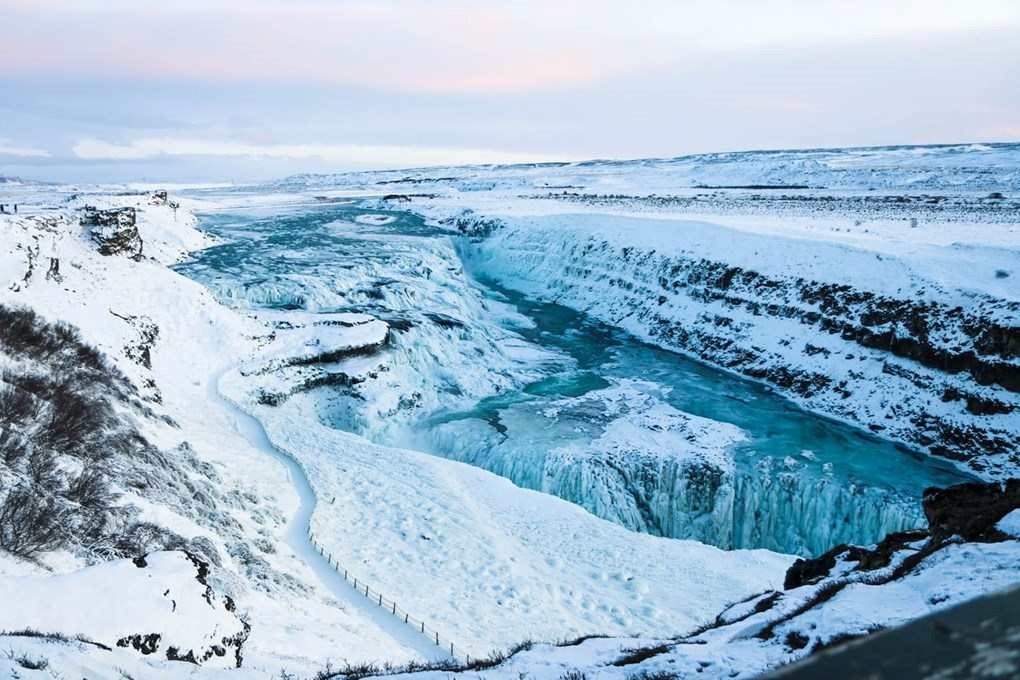
Had your heart set on travelling to another part of Iceland during your winter trip? We recommend only travelling the Ring Road during the winter if you are or have an experienced driver who knows how to drive on snow and ice, as well as plenty of room in your itinerary for potential delays and/or detours. The Ring Road, while frequently travelled, does get more snow and ice in some areas, than what you’ll find in South Iceland. Additionally, closures are common.
Beyond this, some of Iceland’s roadways are completely closed during the winter. For example, most of Iceland’s Westfjords roadways are closed, making the region inaccessible. Furthermore, the Icelandic Highlands are closed completely starting in the fall, around October, and lasting until the early summer.
Want more road trip ideas? Here’s our recommendation for the best Iceland seven-day road trip, and our recommendation for the best Iceland 10-day road trip. You can also find plenty of other Iceland travel inspiration, in our Iceland travel and road trip blog.
5. A 4x4 vehicle will make your Iceland winter trip infinitely easier
We always recommend our clients book a 4x4 vehicle if visiting during the winter, no matter where they plan to travel while in Iceland. A 4x4 vehicle gives you the power and stability you need to traverse snowier, slicker, tougher terrains in safety. But don’t go with just any 4x4 vehicle. A 4x4 SUV will be even better, as the taller vehicle will help you avoid getting stuck in the snow. As a bonus, Lava Car Rental’s 4x4 vehicles are equipped with studded winter tyres from November through April 15, under Icelandic law that requires cars to change from summer tyres to a winter variant for the season.
But beyond the safety features of a 4x4 vehicle, many of our winter travellers find that a 4x4 vehicle also comes with a few other perks, including increased comfort, a smoother ride, more interior room and more luxurious amenities like heated seats. As a result, they’re an ideal option for families or travelling groups.
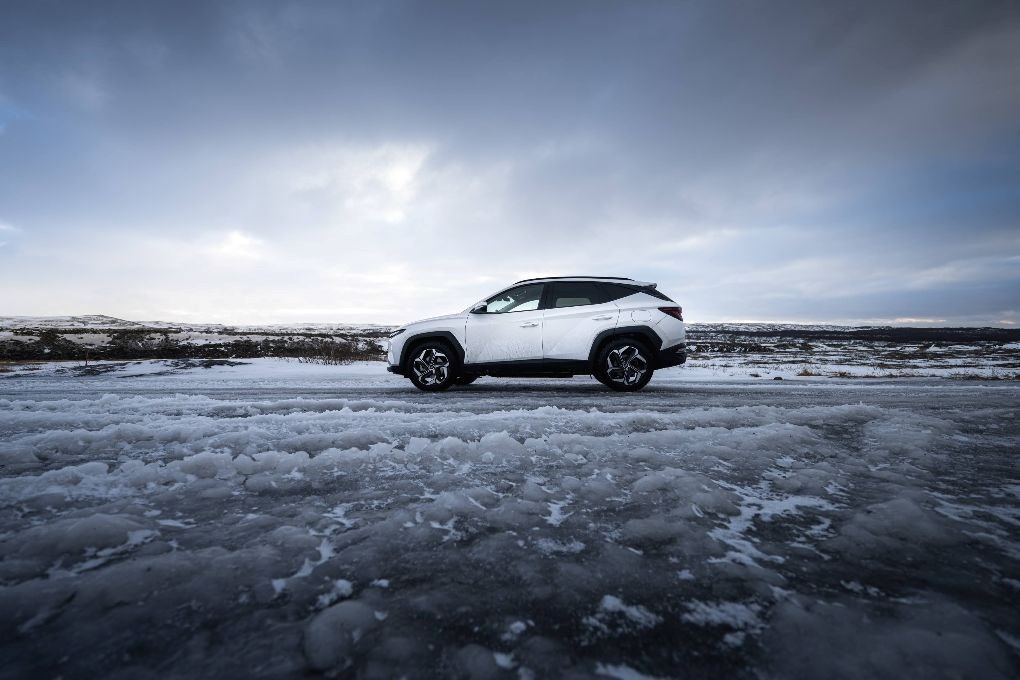
If you’re looking to rent a 4x4 vehicle in Iceland, though, there are a few things you’ll need to know. First, you’ll have to be 20 years of age or older to rent a 4x4. Beyond this, you’ll need a Latin alphabet driver's license (or an English translation of a non-Latin alphabet driver’s license) and a credit or debit card to put on file.
But remember: this is only the case at Lava Car Rental. At other rental car providers around the country, you’ll find stricter policies on renting to international drivers, including restricting rentals to those who’ve had their driver’s license for a year or more, and sometimes increased rental age restrictions, requiring a driver of 23 years of age or older.
6. Tuning in to the right resources will keep you well informed
You can use a few different resources to stay up-to-date and informed on the up-to-the-minute Icelandic weather forecasts and road conditions.
Vedur.is is the place to go for your daily weather updates and any pressing weather warnings. You’ll get information on the entire country for temperature, wind, precipitation and more.
Road.is is the site to visit for road condition updates. The site posts road closure and obstruction information for the entire country and select regions, with updates on everything from road work to thaw conditions to even wildlife on the road (such as reindeer). If you don’t want to keep track of the website, though, you can follow them on Twitter (at @Vegagerdin) for live updates via your social feed.
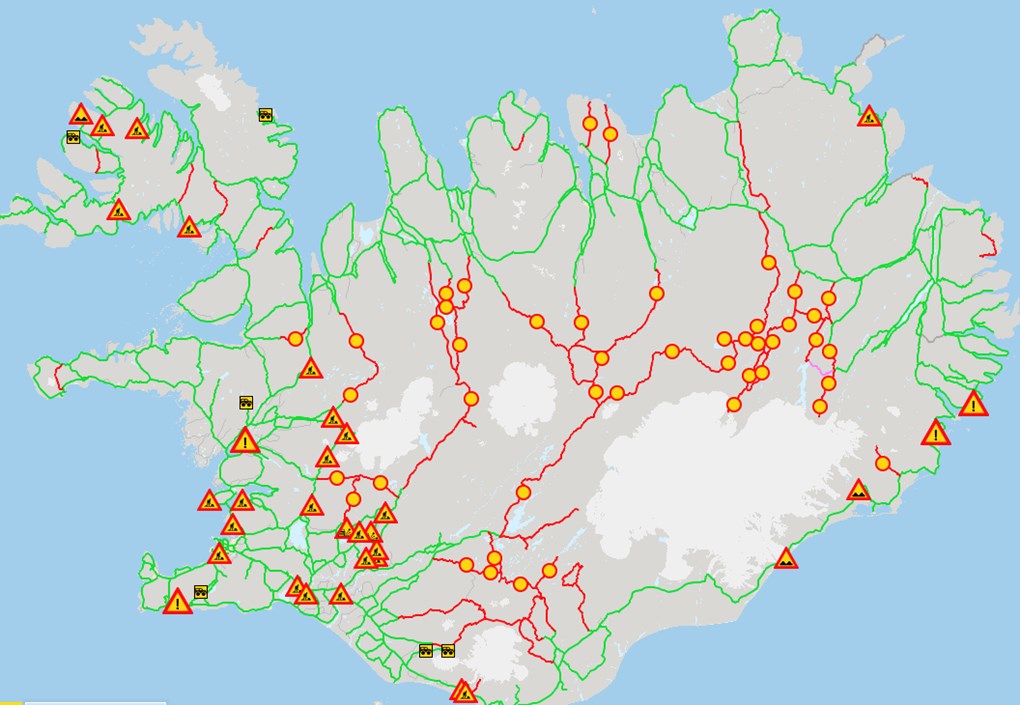
Regardless, road.is will be invaluable to your Iceland winter trip, as road closures are very common in Iceland all year round. Snow, ice, avalanche warnings and even wind can cause closures that last for days at a time. These closures are most common in the north and east, so you may want to plan to stay in the south and west if you’re visiting during the winter months and don’t want to deal with possible closures.
And one fun resource to definitely keep an eye on if you’re visiting during the winter? The Vedur.is aurora forecast. If you don’t want to spend money on a high-priced northern lights tour, you can chase the northern lights all on your own, September through April. The aurora forecast will let you know where and when you have the best chances at spotting the northern lights, based on things like cloud cover and solar activity. Then, if one of the locations is nearby, you can simply hop in your car and drive there.
7. Keeping your days short can save you a headache when travelling around Iceland in the winter
Iceland’s winter daylight hours are short — very short. If you come from a climate where you can rely on the winter sun to stay up from when you wake up until at least 6 p.m., that’s not what you can expect from an Icelandic winter. In the middle of December, Iceland only experiences roughly five hours of daylight per day on average.
Because of this, as well as because of the ever-changing weather conditions, we recommend keeping your itinerary days on the short side when visiting Iceland in the winter. Rather than trying to cram a ton of driving and sightseeing into one day, maybe drive a shorter distance and see one sight or go on one hike.
Planning a looser, less stressful itinerary like this also means you have room to adjust your itinerary if something like the weather interrupts things. And whatever you do — don’t try to fight your way through bad weather just to stick to your itinerary. Even the airlines flying to and from Iceland understand this fact about Iceland travel and, as a result, you may find that your winter flight may get delayed by a day or even two when the weather is right.
To help you in keeping your winter itinerary as stress-free as possible, Lava Car Rental is happy to help in the situation that your trip is delayed or extended due to weather. If you book directly through lavacarrental.is. You’ll get direct access to our team, which can instantly help and assist you in the event of a weather delay or emergency. We’ll even allow you to change your booking for free, up to 48 hours before your vehicle pick-up time, if you simply send us an email at [email protected].
Looking for quick Iceland itineraries that are low-key and low-travel? Check out our guide to short trips near Keflavik Airport. Whatever your interests or whatever kind of traveller you are, you’ll find lots of fun activities all in the near vicinity of the airport, from museums to beaches, hot springs to hikes, and you’ll hardly have to drive very far at all.
Tips for Getting Around in Your Rental Car in Iceland in the Winter
Ready to start planning your Iceland winter road trip based on our seven top things you need to know above? Here are a few extra tips to get you on your way and ensure the smoothest, easiest, most convenient and fun experience possible.
Before you get in your rental car in Iceland in the winter…
What you need to know actually starts before you start driving. Before you even get in your rental car in Iceland in the winter…
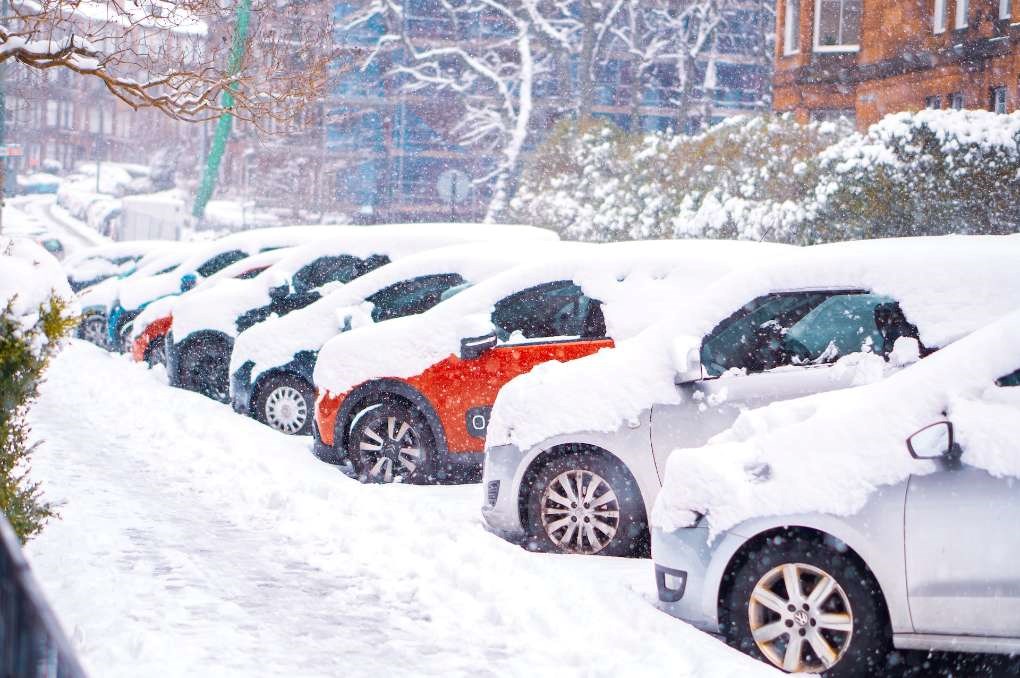
- Check the weather, using www.vedur.is, and the road conditions, using www.road.is.
These sites will give you all the up-to-date information you need to decide whether or not you’re safe to proceed with your day’s travel plans, or if you need to make other plans that are more suitable for the weather and road conditions.
- Go out to your car with the right gear.
Make getting into your vehicle as easily as possible under frigid, snowy, icy winter conditions.
Wear winter clothes. Even if you’re just going from inside to the car, you’ll still need them. It’s winter in Iceland, after all.
Take a light, even if it’s just the flashlight on your phone.
Wear shoe spikes, sometimes called crampons, to prevent slipping on ice as you walk to the car.
- Go to your car and open the door.
This part is easy — or is it? It’s very likely that your car door may be frozen shut if you haven’t opened it in a few hours. If this is the case, you have a few options.
- Try every door on the car to see if one is still unfrozen.
- Wiggle the door and give it a bit of force. You may be able to break the ice by just pulling on the door, if it’s a thin layer.
- Pour warm water on the side of the door. Be careful not to let the water come into contact with the glass on the door, as the sudden change in temperature can shatter it.
Once you’ve made it into the car, turn it on and let it warm up completely.
The best way to prevent frozen doors on cars in Iceland is by parking indoors, if it’s an option, or by keeping a cloth handy to wipe the doors before leaving the car. This can help soak up any lingering moisture and prevent freezing.
- Warm up the car.
As mentioned, once you’ve made it into the car, you’ll want to start it and let it warm up completely. Do note that the car will be frigid at first, so the heating won’t work immediately. It can take a good 15 minutes or so for the air conditioner to begin pumping in hot air.
If you have time, let the car run in place and warm up before you start driving. This will ensure the car is safely heated before you head out on the road, and also make for a more comfortable driving experience. That said, don’t keep the car running too long while you wait for it to warm up, and don’t let it run in an enclosed environment, like in a garage.
If you don’t have time to let the car warm up before you drive, keep yourself bundled up in your winter clothing, and turn on the heated seats, if your vehicle is outfitted with them. You’ll be uncomfortable driving for a few minutes, but will soon warm up as the car does.
- Remove the snow and ice from the car.
If the car is covered in ice and/or snow, you’ll need to remove it from the vehicle before you start driving. Otherwise, both can block your view or fall off the car while driving, potentially causing an accident.
Start by scraping all the frost and snow off the vehicle’s windshields and windows. All should be properly scraped so that you can see out of every window. Not only is this a safety precaution, but removing it will also help the car to heat up faster, so you can get on your way.
Then, clear the snow from the car roof.
Use a scraper made for this purpose, for all of the above, and keep it handy, in a designated spot in your vehicle.
- Remove snow from around the tyres.
Lastly, remove the snow from around the vehicle’s tyres. You may want a small snow shovel for this job. This will help your car gain traction as you try to get on your way, and ensure you’re not left spinning your wheels in place.
When you’re on the road…
Once you get out on the road, be sure to drive carefully, especially at night, when temperatures fall and roads can become icy.
Additionally, check the road conditions not just before you leave on your road trip, but throughout your entire trip, multiple times per day. Your best source for all information on road closures is www.road.is. In fact, sometimes there won’t even be a sign telling you that a road is closed, when you drive to it, so you’ll have to check www.road.is to be sure.
You can find more tips in our guide to driving in Iceland.
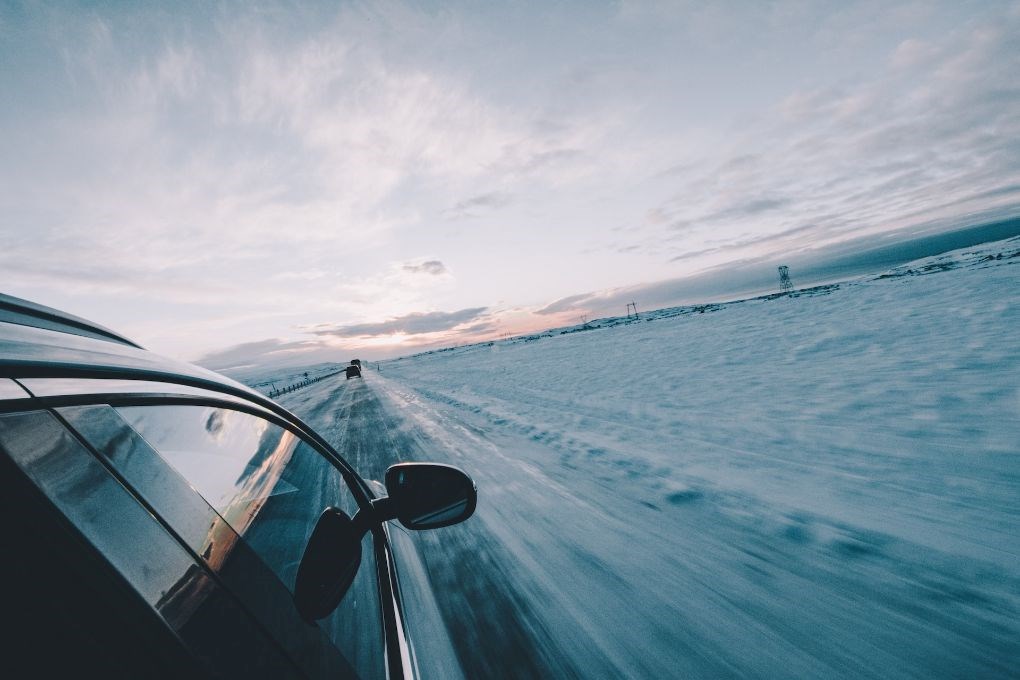
In the evening, when you park your car for the night…
Once you’ve made it to your destination for the evening, you’ll want to do a few things before locking up your rental car and heading inside.
- Park your car carefully.
If you can, park your car out of the elements, such as in an indoor parking lot or garage. If this is not an option, consider parking somewhere that will be cleaned of snow and ice in the morning. Back into your parking spot so you can more easily get out of the spot the next day.
If you’re not sure where to park and what will be easiest/best, ask your accommodation for advice.
- Remove items from the car.
Don’t leave anything in the car overnight, as it all could freeze. Beyond drinks and food, remove extra clothing or suitcases, and even the car’s floor mats. This can all help reduce the risk of moisture leaching into the air and freezing against the doors or windshield. You’ll thank yourself for doing so in the morning, when it’s easier to clean the car and heat it up.
- Check the weather and road conditions for the next day.
Lastly, check the weather and road conditions yet again, so you can plan for your next day accordingly.
Driving in Iceland in the Winter Takes a Little Extra Care, But Can Be Oh-So-Rewarding
An Iceland winter road trip is a one-of-a-kind experience and one that you’ll remember forever. However, making sure you stay safe during such a road trip is crucial — and it all starts with renting the right rental car.
Lava Car Rental offers a wide selection of winter-ready vehicles for your upcoming excursions, including small 4x4 vehicles, large 4x4 SUVs and more. Check out our full selection now.
Search and book your car in Iceland




